2018 UPDATE! Use London Broil steak, cut against the grain (e.g., cut parallel to the short end, not the long end). It is WAY less expensive than skirt steak, and works just as well if not better.
Recipe:
1 gallon Ziplock bag
a cookie sheet (must have a lip) or two
a cookie cooling rack or two
aluminum foil (to wrap around the cookie sheet)
For every 1 to 1 1/2 pound meat you need:
1/4 cup tamari (gluten-free and organic is only pennies more . . . hint hint!)
Juice of 1 lemon
Juice of 1 lime
1/2 teaspoon onion powder (or onion salt, in which case use garlic powder)
1/2 teaspoon garlic salt (see above – if you want to substitute garlic powder, use onion salt – or if you use powder both times, double the salt added below)
1/4 teaspoon black pepper (or less if you don’t want it spicy)
1/8 teaspoon sea salt or Himalayan pink salt
1/8 teaspoon crushed red pepper flakes (or less if you don’t like it spicy)
1/4 teaspoon red sumac (a Lebanese spice I use in everything – this is totally optional but if you find it and use it, you’ll be stuck on it too ;-) ).
Start with Skirt Steak.
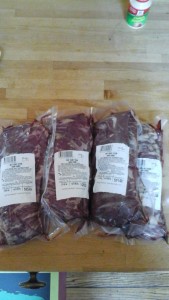
Our local market sells packets of skirt steak in 1-1.5 pound vacuum-sealed packages. These are fantastic, because you can buy a bunch of them at once and freeze them if you’re not going to use them – then when you want some steak, you can take them out of the freezer and throw them right into the sous vide, bringing them up to about 90 degrees “and holding” when you’re at work. (If you don’t have a sous vide, you might want to read my blog HERE.) When you get home, heat up a cast iron skillet super hot, scorch them on each side for a minute or so, voila, done.
But today, these are for jerky.
The photo shows four 1.5ish pound packets. With this recipe, you can double or triple or quadruple or ??? the recipe without any issues. The smallest of the packages in the photograph is just over a pound – the largest is 1.5 pounds. So I’m quadrupling today. Because my butcher’s packages are always about 1 to 1-1/2 pounds, I always figure one package = one “set” of the marinade ingredients listed above.
If you don’t have a market that has these packs, but you do have a market where you can talk to the butcher, just bring him the photo from the blog and say you’d like one of these, please. ;-) It’s not expensive meat – some butchers cut it up to make fajita meat, but it starts like this.
The recipe by and large comes from Haylie Pomroy’s book The Fast Metabolism Diet, which has some great recipes. This one is particularly good.
I started down the Fast Metabolism Diet road last week, and though I haven’t lost any weight, my energy is really good, and I feel great. I blogged about what it entails HERE.
You can use any “meaty meat” – halibut, turkey, buffalo, etc. – but it works particularly well with beef.
My issue with jerky is that it always contains some form of sugar, and/or some sort of preservatives. I’m sure there are jerkies you can order without these, but they’re probably immensely pricey. This recipe is so easy, it’s ridiculous not to make your own.
Cut the steak into 3 strips (against the grain).
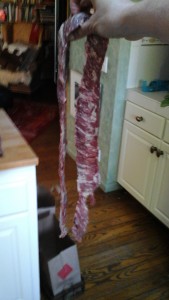
The photo at left is what a skirt steak looks like out of the package. I don’t have a “selfie stick” and even at the end of my condor arm I could barely get it all in the picture. It’s like 3 feet of meat.
If there is any obvious fat, trim it off – but this is a very very lean cut of meat.
The fat you see in this picture doesn’t count as “fat” by the way – that’s just “marbling.” You may, however, run into a bit of fat that run all the way through the meat – particularly at the “fat” end of the meat – that’s what you want to cut off. But to give you some idea, I did not have any in all 4 of the steaks that I cut up before writing this blog.
Get your kitchen shears, and cut the strip the “long way” (against the grain). Your steak will be meatier on one end and less so on the other. So that means you’ll have three strips on one end, and usually as you cut, you’ll wind up with only two strips on the other end.
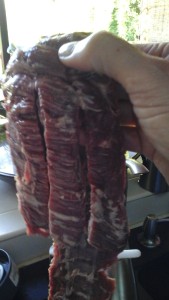
I keep these in as long of strips as they go. (Yes, I’m juvenile enough to sort of make a game of it – like trying to peel an orange in one strip of rind.) Sometimes you hit a weak spot in the meat, so that “strip” breaks off – it’s not important. But if you’re using a full skirt steak, you want the width of the strips to be about 1/3 of the strip at the “fat end” or 1/2 of the strip at the “skinny” end. It’s not rocket science, just do your best ;-)
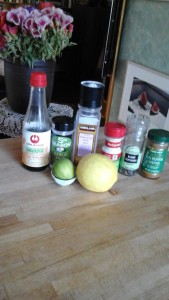
Mix up all the other ingredients into the Ziplock.
Take the ingredients from the above recipe (multiplied by however much meat you have), and put them into a Ziplock. Take it from me, if you use a Ziplock with the actual “zipper” it’s a LOT easier to turn it upside down and shake it than if you use one that you just “press” together. No need for the excitement of the entire marinade and meat concoction slipping out on the floor when you shake it ‘cos you didn’t quite get the tracks of the bag to match….
A gallon Ziplock will take up to four times the recipe above, if you’re wondering. If you’re doing more than four times the recipe, I would use a couple of Ziplocks, but you only need one up to a quadruple recipe.
Again – the thing I really like about this recipe is that there is nothing sweet in it. Honey, sugar, whatever. And it’s delish. Trust me here.
Shake the marinade to mix it together.
 Plop all the meat into the Ziplock.
Plop all the meat into the Ziplock.
Once you have all the strips in there with the marinade, seal the Ziplock almost all the way. Then squeeze down on it so that you get all the air out of the top little opening you’ve left.
Then seal it tight.

Now turn the Ziplock over and over to be sure the marinade gets to all the meat (like I said, this is the exciting part if you aren’t completely sure about your Ziplock zipper…)
Put the Ziplock into the refrigerator overnight (at least 8 hours, but better if it’s overnight).
Whenever you open the refrigerator between then and cooking time, give the Ziplock a few little tosses to move the marinade around on the meat. It will settle on the bottom side, so you want to be sure you let all the pieces get evenly marinaded.
After 8+ hours, drain & discard the marinade.
Squeeze the meat (while still in the Ziplock) to get it pretty dry. The easiest way to do this is to get the bulk of the marinade out first, and then zip the zipper back up most of the way, and squeeze the marinade out the “spout” by rolling it up from the bottom. This is similar to what you did when you were letting the air out to seal it, before putting it in the fridge.
You don’t want to pat the marinade off, but you do want to squeeze out as much of the liquid as you can, because you’re going to be dehydrating that meat, and more liquid = more time.
Take your cookie sheets and wrap them in aluminum foil.
You’ll need about two sheets and two cookie “cooling racks” for about each 3 pounds of meat, give or take.
Because the marinade and fat from the jerky is going to drip onto the aluminum foil, you may want to spray a little coconut oil in between the cookie sheet and the foil. I’m not sure if you have ever had this happen, but sometimes the foil “adheres to” the cookie sheet. So you might want to put a Pam-esque buffer. Personally, I use what are called “baker’s sheets” over my cookie sheets. They are PFOA-free silicone, non-stick, re-usable, and work like a charm. But as most folks don’t have these or do as much in-oven baking/roasting as I do, I am using aluminum foil in this recipe.
Put the cookie cooling racks on top of the aluminum foil, with their “feet” folded in.
If your sheets and racks are the same size as my sheets and racks, the racks will fit inside the lip of the sheet with a pretty good amount of room to spare. That will come up in a second.
If you’re only doing 1x of the recipe (silly you, you’re going to eat all that jerky before anyone gets home . . . :-) ) then you can likely use one sheet, or use two and leave more room between the pieces.
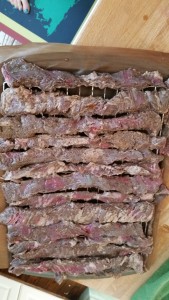
Put the meat on the racks, cutting it to size as you go. It can be close together, but shouldn’t overlap.
Although the recipe I used stated that you have to have the meat strips 1/4″ apart, they shrink up a LOT. So, I snuggled them up close, and as I checked the jerky, I was able to move them farther apart as they shrank. If you leave the strips long, be sure to tuck the ends down into the pan, so that they drip into the pan (not onto the bottom of the oven). That said – I’d still put down aluminum foil in the oven anyway, just in case. ;-)
Remember I mentioned the space between the rack and the sheet? I personally actually laid a couple strips along the “long side” of the sheet (between the sheet and the rack) and then another along the “short side.” The jerky drips a LOT as it’s dehydrating, but that basically means that about 1/2 way through, you’ll be able to move those strips up to the rack and out of the drippings.
As you can probably tell, I’m not too fussy of a cook ;-) I just wanted to be sure that you knew that everything came out just fine when I did things this way. I wasn’t interested in doing two batches, because that’s a lot of time. So I made it work. Also, to give you an idea, I’m doing 4x the recipe this time around (I did 3x last time), and I’m still going to use the same setup. They really do shrink up a lot as they cook.
Bake the strips uncovered at 200 degrees for about 3 hours.
At three hours, you want your oven timer to go off so you can check on them. If you have two pans of strips, this is the time to swap the bottom pan for the top pan. It’s also time to re-arrange the strips as you may need. You can taste one, but they’re not going to be close.
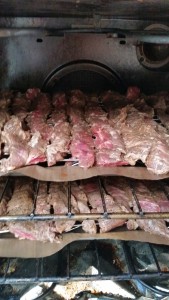
If you have some other situation – more strips down the sides/off the rack or some such, you’re going to need to get them up on the rack as soon as you can. So you might be checking more than just once at 3 hours and once when “nearly done.” But this is what I did. At 3 hours they had shrunk in enough for me to get all the strips that were off the rack onto the rack, plus I was able to re-arrange them to allow a bit more room between all the strips.
Bake the strips for about another 3 hours.
I say “about” because I have a convection oven, and mine were done at 6 hours total. If you don’t have a convection oven, I think it’s going to be more like 7 hours. Leave the temperature the same, don’t cover them . . . just do what you just did, and come back 3 hours later and check on them.
You’ll know they are done when the meat is dry and leathery. And you can’t stop eating it.
Remove from the oven and cool completely before refrigerating or freezing in an airtight container. (I just took the cookie cooling racks off the pans and set them aside until the jerky was cold.)
If, that is, you can make it that far, and don’t eat them all as you’re waiting for them to cool. ;-) .
On this Haylie Pomroy eating plan, the first two days are basically fruit/veg/grains/some protein, then the next two are strictly veg/protein (with protein as the snacks – enter the jerky), then the last three days are a lot more relaxed with fruit/veg/protein/grains.
I made the jerky on the first of the middle two days, and actually weighed out how much 3 ounces was, to be sure I got the snack portion right. Yeah . . . then I weighed out 6 ounces, to get the lunch portion right . . . and another 3 ounces for the next snack . . .
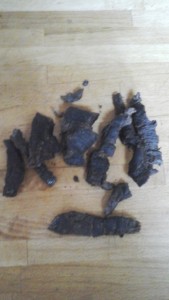
It’s very addictive, and so easy to make!
By the way, the aluminum foil is going to be coated with a thick mixture of hardened on marinade, fat, etc. While the jerky is cooling, get that off the cookie sheet and throw it away. (As I use baker’s sheets, I just hit them with super hot water and this slides right off, then I pat the sheet dry, and hang it to use for the next roasting/baking extravaganza ;-) ) If you have a dog or animal that might go through your trash, I recommend crumpling it up into a ball and zipping it into the Ziplock that you marinated the meat in. It’s harder to smell that way ;-)
Any questions…?
And..speaking of recipes…tonight is roasted chicken night – if you didn’t catch it last time, HERE is the recipe for the easiest and best roast chicken in the Universe ;-)
